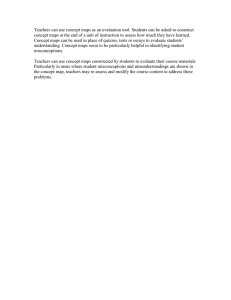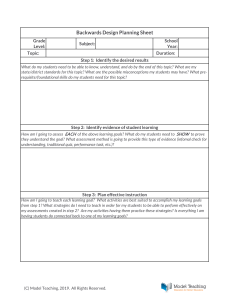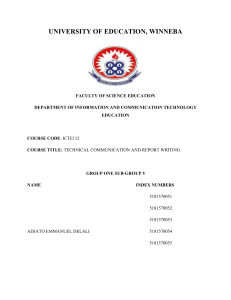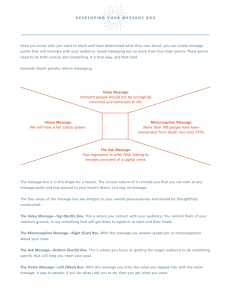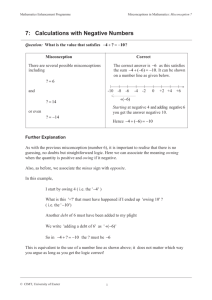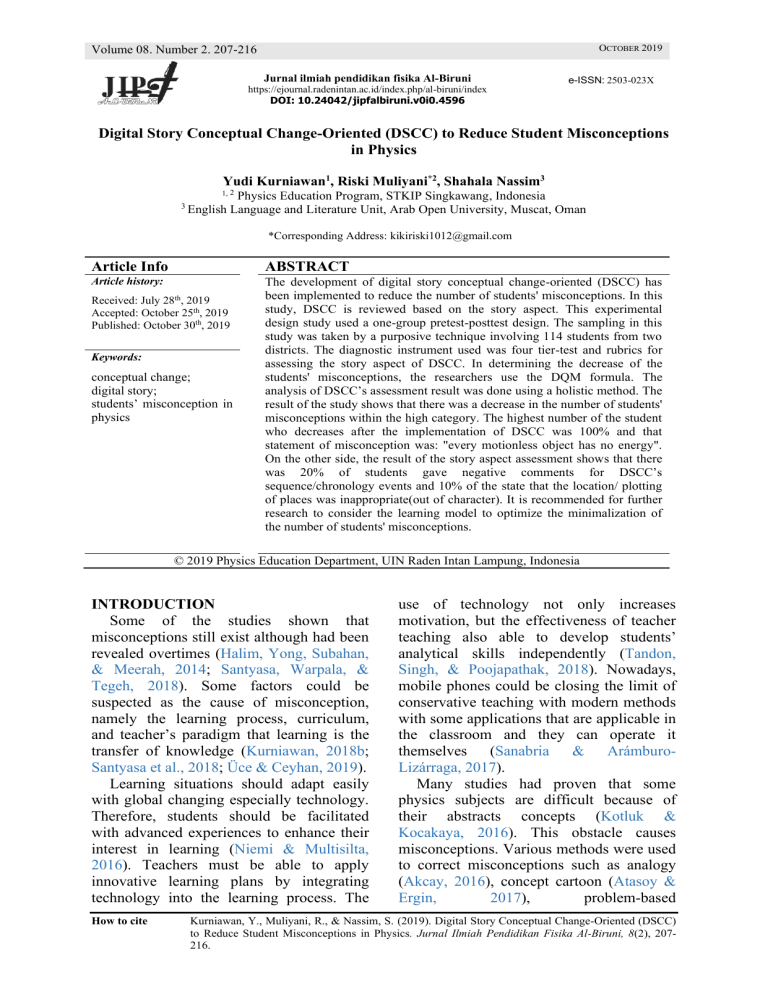
OCTOBER 2019 Volume 08. Number 2. 207-216 Jurnal ilmiah pendidikan fisika Al-Biruni e-ISSN: 2503-023X https://ejournal.radenintan.ac.id/index.php/al-biruni/index DOI: 10.24042/jipfalbiruni.v0i0.4596 Digital Story Conceptual Change-Oriented (DSCC) to Reduce Student Misconceptions in Physics Yudi Kurniawan1, Riski Muliyani*2, Shahala Nassim3 1, 2 3 Physics Education Program, STKIP Singkawang, Indonesia English Language and Literature Unit, Arab Open University, Muscat, Oman *Corresponding Address: kikiriski1012@gmail.com Article Info ABSTRACT Article history: The development of digital story conceptual change-oriented (DSCC) has been implemented to reduce the number of students' misconceptions. In this study, DSCC is reviewed based on the story aspect. This experimental design study used a one-group pretest-posttest design. The sampling in this study was taken by a purposive technique involving 114 students from two districts. The diagnostic instrument used was four tier-test and rubrics for assessing the story aspect of DSCC. In determining the decrease of the students' misconceptions, the researchers use the DQM formula. The analysis of DSCC’s assessment result was done using a holistic method. The result of the study shows that there was a decrease in the number of students' misconceptions within the high category. The highest number of the student who decreases after the implementation of DSCC was 100% and that statement of misconception was: "every motionless object has no energy". On the other side, the result of the story aspect assessment shows that there was 20% of students gave negative comments for DSCC’s sequence/chronology events and 10% of the state that the location/ plotting of places was inappropriate(out of character). It is recommended for further research to consider the learning model to optimize the minimalization of the number of students' misconceptions. 28th, Received: July 2019 Accepted: October 25th, 2019 Published: October 30th, 2019 Keywords: conceptual change; digital story; students’ misconception in physics © 2019 Physics Education Department, UIN Raden Intan Lampung, Indonesia INTRODUCTION Some of the studies shown that misconceptions still exist although had been revealed overtimes (Halim, Yong, Subahan, & Meerah, 2014; Santyasa, Warpala, & Tegeh, 2018). Some factors could be suspected as the cause of misconception, namely the learning process, curriculum, and teacher’s paradigm that learning is the transfer of knowledge (Kurniawan, 2018b; Santyasa et al., 2018; Üce & Ceyhan, 2019). Learning situations should adapt easily with global changing especially technology. Therefore, students should be facilitated with advanced experiences to enhance their interest in learning (Niemi & Multisilta, 2016). Teachers must be able to apply innovative learning plans by integrating technology into the learning process. The How to cite use of technology not only increases motivation, but the effectiveness of teacher teaching also able to develop students’ analytical skills independently (Tandon, Singh, & Poojapathak, 2018). Nowadays, mobile phones could be closing the limit of conservative teaching with modern methods with some applications that are applicable in the classroom and they can operate it themselves (Sanabria & ArámburoLizárraga, 2017). Many studies had proven that some physics subjects are difficult because of their abstracts concepts (Kotluk & Kocakaya, 2016). This obstacle causes misconceptions. Various methods were used to correct misconceptions such as analogy (Akcay, 2016), concept cartoon (Atasoy & Ergin, 2017), problem-based Kurniawan, Y., Muliyani, R., & Nassim, S. (2019). Digital Story Conceptual Change-Oriented (DSCC) to Reduce Student Misconceptions in Physics. Jurnal Ilmiah Pendidikan Fisika Al-Biruni, 8(2), 207216. 208 Jurnal ilmiah pendidikan fisika Al-Biruni, 08 (2) (2019) 207-216 learning(Tasoglu & Bakac, 2014), and computer assisted-learning (Üce & Ceyhan, 2019; Wartono, Hartoyo, Nilasari, & Batlolona, 2019) including through real and virtual experiments (Halim et al., 2014; Muliyani & Kaniawati, 2015). Although both real and virtual experiment methods have been applied in the class, the chance of misconception exists remains. If misconceptions remain, it is precisely due to the absence of cognitive conflict, especially in students who lack understanding even after being reinforced by using media or using an experiment because students are only enabled to interpret limited information based on a provided rule (Potvin & Cyr, 2017). In this study, the researcher offered alternative ways of teaching by using technology-integrated media into a classroom called a digital story. In Indonesia (especially in the physics subject), it has not been applied yet in physics learning. Most of the studies about digital stories concern to the English or linguistic subject(Maddine, 2014; Nassim, 2018; Prins, 2017), students’ participation, and students’ self-efficacy (Yildiz Durak, 2018). The other digital stories contain pictures, texts, and audio recorded coherently (Razmi, Pourali, & Nozad, 2014; Thang et al., 2014). The digital story in this study combines all of them in one format (in .mp4). These are the essential differences so the student can observe the DSCC directly on the display by only push the ”play” button. Moreover, a digital story can cover a large area, both in terms of delivery techniques, the deliverer, and flexibility in choosing the content to be involved. This media could create a joyful situation for the student while learning in the class, experiencing extraordinary activities so they could possess multiple skills at the end of class (Nassim, 2018). A digital story is not only applicable to young learners, but it is also applicable to be used by adult learners. A lot of adults wants to expand their skill and knowledge especially in using technological devices. The making of a digital story could be interesting for adults by using variances of multimode text or semiotic resources (Prins, 2017). The interaction between digital story content and students will increase students' involvement, which in turn, will support the achievement for better learning outcomes (Choi, 2018). A digital story is considered to be used because it could be applied in the various scientific disciplines and it can improve students’ achievement compared to PowerPoint presentations (Özpinar, Gökçe, & Yenmez, 2017). It can train high-level thinking skills, increase motivation, and bring forth competent student performance, writing skills, reading skills, enhance student concentration, and improve pleasant learning situation in writing(Dewi, Savitri, Taufiq, & Khusniati, 2018). Moreover, the application of technology in learning can be a solution for independent learning problems with diverse levels of cognitive ability of students (Hussain & Shiratuddin, 2016). In this study, the researchers tried to design a digital story-oriented conceptual change (DSCC) with the form of video animation so that it differs from digital story designs in general. Also, this digital story is used as an instrument to help diagnose students' misconceptions. Thus, this study aims to describe the effect of digital stories in decreasing the number of students' misconceptions. METHODS This study is a pre-experimental study using a one-group pretest-posttest research design. This study process is shown in Figure 1. Also, the subjects involved in responding to DSCC were middle school students who had learned the concept of energy, specifically 114 students from two subdistricts. Jurnal Ilmiah Pendidikan Fisika Al-BiRuNi, 08 (2) (2019) 207-216 209 Table 1. DQM category Tier1 Tier2 Tier3 Tier4 R C R C R W R W UC UC UC UC R R W R UC UC UC C R C R UC Figure 1. Research Process Chart R UC R C The instrument used to measure digital stories is the observation rubric. To measure the extent to which the reduction in the number of misconceptions, an instrument in the form of a four-tier test (FTT) was used. To determine the students' misconceptions, the researcher refers to the scoring proposed in the previous version designed by Muliyani & Kaniawati (2015) with modification from three-tiers to four-tiers questions. By referring to this decision, the results of the analysis of student answers will be matched to the content of table 1. The calculation to know the extent of the reduction in students' misconceptions refer to equation (1). In the analysis process, the researchers adopted an argument that a student is categorized to have misconceptions if they give the wrong answer either on tier-1 and/or on tier-3 (Muliyani, 2018). The incorrect conceptions or partial/incomplete conception before getting scientific information that the definition is contradictory to the scientists' definition belongs as a misconception. Most of the term in daily life is not the same as the term in the scientific field. The subject matter in class is not enough to represent their beliefs on surrounding events (Aydın, 2017). R C W UC W UC W UC W W W W W R R C C C C UC C UC R R W W W W W C UC C UC C C C Decision Scientific conception Lucky guess Guess Guess Guess Lack of Knowledge Lack of Knowledge Lack of Knowledge Unknown Concept Misconception Misconception Misconception Misconception Misconception Misconception Misconception Explanation: R: right W: wrong UC: uncertain C: certain The results of FTT answer analysis were calculated by adopting the DQM equation by Kurniawan et al., (2016) and the results were immediately categorized according to Table 2. DQM = % pretest − % posttest 100% % pretest − %ideal (1) (Kurniawan et al., 2016) DQM = the percentage of students' misconceptions decreases. % ideal = 0 (percentages of the number of students' misconception). Tabel 2.DQM Category Categories Low Medium High Interval of DQM 0 DQM 30 30 DQM 70 70 DQM 100 (Kurniawan et al., 2016) The researchers summarized some research related to the concept of physics 210 Jurnal ilmiah pendidikan fisika Al-Biruni, 08 (2) (2019) 207-216 that is a misconception. For this study, the physics subject tested was the concept of energy with the distribution of misconceptions as shown in table 3. Table 3. Distribution of Misconception Misconception Operational definition Mis-1 If the speed of a moving object is doubled, then its kinetic energy is also doubled Mis-2 Gravitational potential energy only depends on the height of the object. Mis-3 Every motionless object has no energy Mis-4 the only form of potential energy is gravity To measure the digital story in this study, an instrument was designed in the form of a rubric to measure the Story Aspect (SA) with indicators according to Table 4.These indicators are designed and adjusted based on the needs of physics lessons. Tabel 4. Indicator of Story Aspect (SA) Story Aspect Chronology of events Location of events Operational definition The relevance of the sequence of events The selection of the store location The assessment of each SA indicator is in the form of scale that comprised of 1 (Less), 2 (Enough), and 3 (Excellent) of the holistic approach proposed by (Troitschanskaia et al., 2019). This assessment divides some criteria to sub-criteria that integrated each other (Zlatkin-Troitschanskaia, Shavelson, Schmidt, & Beck, 2019). Holistic assessment concern with some criteria that each item has a minimum and maximum score (Metruk, 2018). All of the results were analyzed and converted into percentages. For example, the scoring summary of the SA indicators can be seen in table 5. This scoring method is effortless, quick, and accurate to assess the DSCC. Tabel 5.Scoring Guidelines for Story Aspects Story Aspects 1 2 3 Chrono logy of events The flow of events is not logical and or not related The flow of events is logical but not related. Locatio n of events The location is incorrect and does not add information The location is right but doesn't add informati on The flow of events is logical and has a close relations hip The location is correct and added informati on RESULTS AND DISCUSSION The data collection process was begun by giving students a pre-test before the DSCC implementation. While DSCC was being shown in front of the class, the students had written their opinion on the provided assessment sheet. After this sheet was collected by the teacher, the student finished this stage with a posttest. The DSCC in this study included the learning process at the time of treatment because of its nature as a learning media so that the implementation is flexible. Based on the results of data analysis by using equation (1), it can determine the number of students who have misconceptions both before learning and after learning. The results are shown in Figure 2. Figure 2. Misconception Analysis by Using DQM Equation. Jurnal Ilmiah Pendidikan Fisika Al-BiRuNi, 08 (2) (2019) 207-216 211 Figure 2 shows that the implementation of DSCC reduces all of the misconceptions. Refers to table 2, all of the misconceptions decreased in the high category (> 70%). The largest decrease is in the Mis-3 which achieves an ideal condition (0% of students' misconceptions). The processes repairing the misconception by using a sample of DSCC are shown in Figure 3 and Figure 4. Figure 3. The DSCC Implementation Scene 1-2 (Indonesian version) Figure 4. The DSCC Implementation Scene 3-7 (Indonesian version) Furthermore, the results of the assessment of DSCC were assessed based on the story aspect (SA) indicators by adjusting the three categories, such as: excellent (3), good (2), and bad (1). Each value must refer to table 4. Only the DSCC that meets all the requirements of SA could have maximum scores. Figure 5 shows that chronological events were is dominant at a good category and the location of events is at the excellent category. This is linear with the results of the FTT which still leaves few students with misconceptions. There were 30% of the total students stated that both the chronological events (20%) and location of the event (10%) were difficult to understand. The hardest part of the Digital story was recording/identifying the information based 212 Jurnal ilmiah pendidikan fisika Al-Biruni, 08 (2) (2019) 207-216 on the displayed story. This result is supported by Yildiz Durak (2018), who states that the most disliked part is capturing stories/ messages from the digital stories. In other words, the difficulties in finding the concept/information are linear with student confusion by assessing/observing the DSCC presentations (in this case, chronological and location). Therefore, the students’ needs are a priority in learning using the concept of technology integration design. Another factor that indicates relevant to this limitation is the display duration. Some DSCCs need a duration of about 1 minute – 2 minutes. It could affect the respondent that almost of them in the age range of 13-15 years old, thus, their readiness ability may differ between one another (Balaman, 2017). Figure 5. Story Aspect of DSCC The decrease in students' misconceptions has been predicted because DSCC is designed to break students’ beliefs. Psomos & Kordaki (2015) state that the storytelling technique could be learning media to solve misconceptions. This result implies that digital story content is very innovative, the learning goal is clearly illustrated, the media very easy to operate, can support learning because it increases students’ interest, increases students’ activity, and increases students’ skills(Batsila & Tsihouridis, 2016). Almost all of the learning process in the use of digital stories is fun and entertaining except in finding the main information/concepts presented in the story (Yildiz Durak, 2018). Moreover, activities in DSCC allow the students to analyze the phenomenon at the time, investigate digital sources, and able to make a decision and solve problems collaboratively in class (Vivitsou, Niemi, & Kallunki, 2017). The highest misconception (13%) is at the Mis-1 with the statement"if the speed of a moving object is made double, then the kinetic energy also increases twice". This is due to students' thinking that tends to believe without further understanding the statement that moving objects must have kinetic energy (Kurniawan, 2018b). Also, students often analogize everyday phenomena in an event but, the case is not the same (Kurniawan, 2018a). In terms of DSCC, the integration of DSCC into a particular learning model can also lead to not achieving ideal conditions (0% misconception). Although the whole process of the digital story is planned carefully, the selection of learning model references should be considered for the achievement of optimal results (Hussain & Shiratuddin, 2016). As stated as at the beginning of this article, the digital story in the prior studies was not focused on the physics subject, but it focused on the English subject, literacy, English language art (Maddine, 2014; Nassim, 2018; Prins, 2017) especially in misconception topics. Thus, this result could be basis data for the improvement of DSCC in another physics subject. The result of this study belongs to the outstanding category (Hussain & Shiratuddin, 2016) because these digital stories (DSSC) implement the scenario of learning models. The achievement of DQM’s category is in the high category. The finding in Figure 5 also shows that the location aspect is the aspect of the negative vote. After further identification, it is known that the majority of respondents wanted an explanation that is displayed clinically, for example in the form of a free diagram that reinforces the explanation of Jurnal Ilmiah Pendidikan Fisika Al-BiRuNi, 08 (2) (2019) 207-216 213 the information contained in Figure 2. Technical-related materials certainly inhibit students because the information displayed is not fully understood by students. This technical issue also becomes an obstacle because the process of using digital stories is very closely related to the absorption of information. (Nassim, 2018). The sample of the instrument used to diagnose misconceptions is shown in Figure 6. elements such as the systematic solution of physics problems through the representation of force diagram drawings or the like. Misconception : The potential energy depends on the object’s height only. Item indicator: Determine the net potential energy with a different mass on the same height level. AUTHOR CONTRIBUTIONS YK conceptualizes ideas and designs research designs. RM makes media and research instruments. YK and SN analyzed the data and performed calculations. SN records the results and writes the discussion. Figure6. Example of Diagnostic Test (Indonesian Version) CONCLUSION AND SUGGESTION Based on the results and discussion, it can be concluded that the DSCC as a learning media has successfully reduced misconceptions within the high category, more than 70%. In further research, it is recommended to consider the development of DSCC that is adapted to the learning model that will be used so that students who are still misconceptions become zero. The DSCC presentation should display physical ACKNOWLEDGMENT The researcher would like to thank DRPM Kemenristekdikti for the implementation of this research through the Research Grant Program: Penelitian Dosen Pemula with contract: 619 / L11 / KM / 2019. REFERENCES Akcay, S. (2016). Analysis of Analogy Used in Secondary Education Science Textbooks in Turkey. Educational Research and Reviews, 11(19), 1841– 1851. https://doi.org/10.5897/err2016.2984 Atasoy, Ş., & Ergin, S. (2017). The Effect of Concept Cartoon-Embedded Worksheets on Grade 9 Students’ Conceptual Understanding of Newton’s Laws of Motion. Research in Science and Technological Education, 35(1), 58–73. https://doi.org/10.1080/02635143.2016. 1248926 Aydın, S. (2017). Eliminating the Misconceptions about Image Formations in Plane Mirrors by Conceptual Change Texts. International Journal of Social Sciences and Education Research, 3(4), 1394–1403. https://doi.org/10.24289/ijsser.320030 Balaman, F. (2017). The Effects of Digital Storytelling on the Students’ Project Based Virtual Learning Qualifications. Curr Res Educ, 3(32), 81–94. Batsila, M., & Tsihouridis, C. (2016). “Once Upon a Time there was...” A Digital 214 Jurnal ilmiah pendidikan fisika Al-Biruni, 08 (2) (2019) 207-216 World for Junior High School Learners. International Journal of Emerging Technologies in Learning, 11(3), 42–50. https://doi.org/10.3991/ijet.v11i03.537 0 Choi, G. Y. (2018). Learning through Digital Storytelling: Exploring Entertainment Techniques in Lecture Video. Educational Media International, 55(1), 49–63. https://doi.org/10.1080/09523987.2018. 1439710 Dewi, N. R., Savitri, E. N., Taufiq, M., & Khusniati, M. (2018). Using Science Digital Storytelling to Increase Students’ Cognitive Ability. International Conference on Science Education (Vol. 1006, pp. 1–5). https://doi.org/10.1088/17426596/1006/1/012020 Halim, L., Yong, T. K., Subahan, T., & Meerah, M. (2014). Overcoming Students’ Misconceptions on Forces in Equilibrium: An Action Research Study. Creative Education, 5(June), 1032–1042. https://doi.org/dx.doi.org/10.4236/ce.2 014.511117 Hussain, H., & Shiratuddin, N. (2016). The digital Storytelling Process: A Comparative Analysis from Various Experts. In Proceedings of the International Conference on Applied Science and Technology 2016 (ICAST’16) (Vol. 1761, pp. 1–7). https://doi.org/10.1063/1.4960884 Kotluk, N., & Kocakaya, S. (2016). Researching and Evaluating Digital Storytelling as A Distance Education Tool in Physics Instruction: An Application with Pre-Service Physics Teachers. Turkish Online Journal of Distance Education, 17(1), 87–99. https://doi.org/10.17718/tojde.59900 Kurniawan, Y. (2018a). Investigasi Level Miskonsepsi pada Hukum III Newton. Jurnal Riset Dan Kajian Pendidikan Fisika, 5(1), 17–21. Retrieved from http://journal.uad.ac.id/index.php/JRKP F/article/viewFile/8625/pdf_65 Kurniawan, Y. (2018b). Investigation of the Misconception in Newton II Law. Jurnal Pena Sains, 5(1), 11–18. Kurniawan, Y., Suhandi, A., & Hasanah, L. (2016). The Influence of Implementation of Interactive Lecture Demonstrations (ILD) Conceptual Change Oriented toward The Decreasing of The Quantity Students' Misconceptions on The Newton’s First Law. In AIP Conference Proceedings (Vol. 1708, pp. 07007-1-070007–5). https://doi.org/10.1063/1.4941180 Maddine, E. (2014). Monitoring and Assessing Digital Story Projects in Middle Grades English Language Arts. Kentucky Journal of Excellence in College Teaching and Learning, 12(1), 647–654. Retrieved from http://www.editlib.org/p/22117 Metruk, R. (2018). the Journal of Teaching English for Specific and Academic Purposes Comparing Holistic and Analytic Ways of Scoring in the Assessment of Speaking Skills. The Journal of Teaching English For Specific and Academic Purposes, 611189(1), 179–189. https://doi.org/10.22190/JTESAP18011 79M Muliyani, R. (2018). The Implementation of Refutation Text in Predict-ObserveExplain (POE) Learning Model to Decrease Students’ Misconception. Journal of Educational Research and Evaluation, 2(2), 62–71. Retrieved from https://ejournal.undiksha.ac.id/index.ph p/JERE Muliyani, R., & Kaniawati, I. (2015). Identification of Quantity Students’ Misconceptions on Hydrostatic Pressure with Three Tier-Test. In Global Trends in Academic Research (Vol. 2, pp. 716–721). Retrieved from www.globalilluminators.org Nassim, S. (2018). Digital Storytelling: An Jurnal Ilmiah Pendidikan Fisika Al-BiRuNi, 08 (2) (2019) 207-216 Active Learning Tool for Improving Students’ Language Skills. PUPIL: International Journal of Teaching, Education and Learning, 2(1), 14–27. https://doi.org/10.20319/pijtel.2018.21. 1427 Niemi, H., & Multisilta, J. (2016). Digital Storytelling Promoting Twenty-First Century Skills and Student Engagement. Technology, Pedagogy and Education, 25(4), 451–468. https://doi.org/10.1080/1475939X.2015 .1074610 Özpinar, İ., Gökçe, S., & Yenmez, A. A. (2017). Effects of Digital Storytelling in Mathematics Instruction on Academic Achievement and Examination of Teacher-Student Opinions on the Process. Journal of Education and Training Studies, 5(10), 137. https://doi.org/10.11114/jets.v5i10.259 5 Potvin, P., & Cyr, G. (2017). Toward a Durable Prevalence of Scientific Conceptions: Tracking The Effects of Two Interfering Misconceptions about Buoyancy from Preschoolers to Science Teachers. Journal of Research in Science Teaching, 54(9), 1121– 1142. https://doi.org/10.1002/tea.21396 Prins, E. (2017). Digital Storytelling in Adult Education and Family Literacy: A Case Study from Rural Ireland. Learning, Media and Technology, 42(3), 308–323. https://doi.org/10.1080/17439884.2016. 1154075 Psomos, P., & Kordaki, M. (2015). A Novel Educational Digital Storytelling Tool Focusing on Students Misconceptions. Procedia - Social and Behavioral Sciences, 191(2005), 82–86. https://doi.org/10.1016/j.sbspro.2015.0 4.476 Razmi, M., Pourali, S., & Nozad, S. (2014). Digital Storytelling in EFL Classroom (Oral Presentation of the Story): A Pathway to Improve Oral Production. 215 Procedia - Social and Behavioral Sciences, 98(2011), 1541–1544. https://doi.org/10.1016/j.sbspro.2014.0 3.576 Sanabria, J. C., & Arámburo-Lizárraga, J. (2017). Enhancing 21st Century Skills With AR: Using the Gradual Immersion Method to Develop Collaborative Creativity. Eurasia Journal of Mathematics, Science and Technology Education, 13(2), 487–501. https://doi.org/10.12973/eurasia.2017.0 0627a Santyasa, I. W., Warpala, I. W. S., & Tegeh, I. M. (2018). The Effect of Conceptual Change Model in the Senior High School Students’ Understanding and Character in Learning Physics. SHS Web of Conferences (Vol. 42, p. 00058). https://doi.org/10.1051/shsconf/201842 00058 Tandon, A., Singh, M. S., & Poojapathak, M. (2018). Latest Trends and Innovations in Teaching & Learning Methods. International Conference on Recent Innovation in Management, Engineering, Science and Technology (pp. 513–518). Tasoglu, A. K., & Bakac, M. (2014). The Effects of Problem Based Approach on Conceptual Understanding in Teaching of Magnetism Topics. Eurasian Journal of Physics and Chemistry Education, 6(2), 110–122. Thang, S. M., Sim, L. Y., Mahmud, N., Lin, L. K., Zabidi, N. A., & Ismail, K. (2014). Enhancing 21st Century Learning Skills Via Digital Storytelling: Voices of Malaysian Teachers and Undergraduates. Procedia - Social and Behavioral Sciences (Vol. 118, pp. 489–494). Elsevier B.V. https://doi.org/10.1016/j.sbspro.2014.0 2.067 Üce, M., & Ceyhan, İ. (2019). Misconception in Chemistry Education and Practices to Eliminate Them: 216 Jurnal ilmiah pendidikan fisika Al-Biruni, 08 (2) (2019) 207-216 Literature Analysis. Journal of Education and Training Studies, 7(3), 202. https://doi.org/10.11114/jets.v7i3.3990 Vivitsou, M., Niemi, H., & Kallunki, V. (2017). Teachers’ Practices to Support Student Work in Digital Storytelling: A Study on Finnish and Chinese School Teachers’ Experiences. Seminar.Net, 13(2), 1–23. Wartono, Hartoyo, D., Nilasari, & Batlolona, J. R. (2019). Real-Virtual Monte Carlo Simulation on ImpulseMomentum and Collisions. Indonesian Journal of Electrical Engineering and Computer Science, 13(1), 7–14. https://doi.org/10.11591/ijeecs.v13.i1.p p7-14 Durak, H., Y. (2018). Digital Story Design Activities Used for Teaching Programming Effect on Learning of Programming Concepts, Programming Self-Efficacy, and Participation and Analysis of Student Experiences. Journal of Computer Assisted Learning, 34(6), 740–752. https://doi.org/10.1111/jcal.12281 Zlatkin-Troitschanskaia, O., Shavelson, R. J., Schmidt, S., & Beck, K. (2019). On the Complementarity of Holistic and Analytic Approaches to Performance Assessment Scoring. British Journal of Educational Psychology, 1–17. https://doi.org/10.1111/bjep.12286

